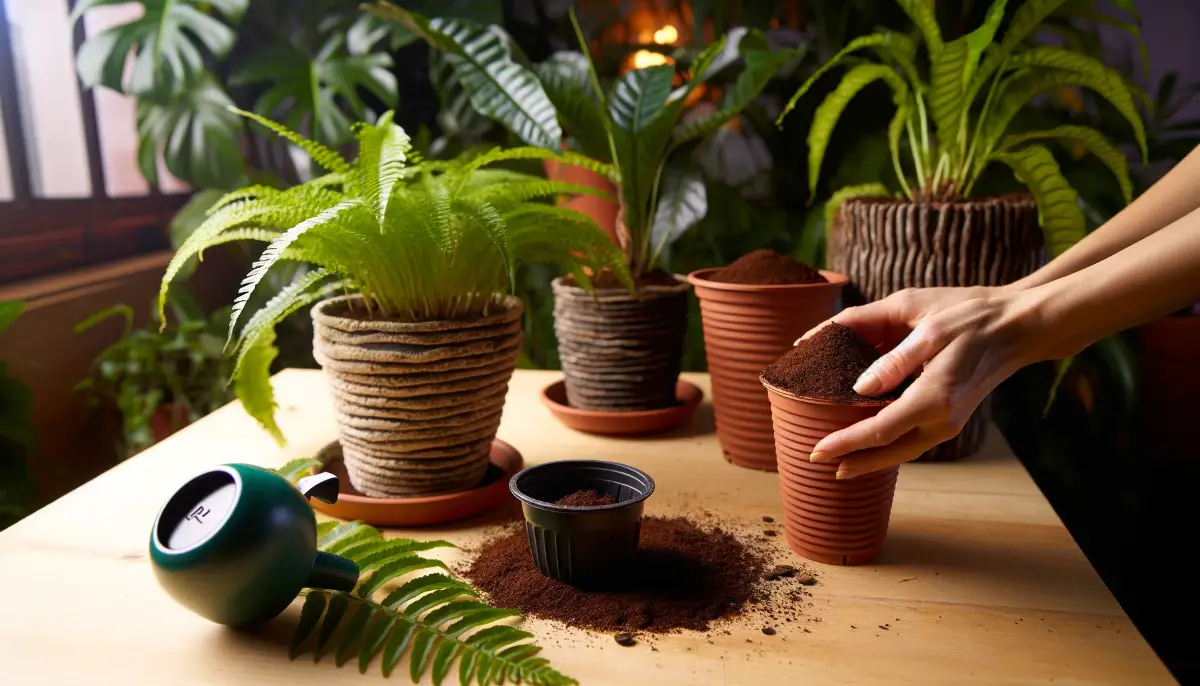Growing your own coffee plant can add a unique touch of greenery to your home and even lead to your very own brew.
Coffee plants (Coffea spp.), with their glossy green leaves and aromatic blossoms, offer more than just the promise of fresh coffee beans; they bring a piece of the tropics right into your living room.
Whether you’re a seasoned gardener or a beginner, understanding the basics of coffee plant care can transform your indoor gardening experience.
What is a Coffee Plant
The coffee plant, scientifically known as Coffea, is a member of the Rubiaceae family and originates from various regions in Africa and Asia. This perennial evergreen can grow into a small tree or shrub and is primarily cultivated for its seeds, commonly referred to as coffee beans. These beans are harvested and processed to produce one of the world’s most beloved beverages—coffee.
Origins and Species
Coffee plants are believed to have originated in Ethiopia, with historical records tracing their cultivation back hundreds of years. The two most commercially significant species are Coffea arabica (Arabica) and Coffea canephora (commonly known as Robusta). Arabica is prized for its mild, aromatic flavor and accounts for about 70% of the world’s coffee production, while Robusta, which tends to be more bitter and contains higher caffeine content, is often used in espresso blends and instant coffee products.
Characteristics
Coffee plants can reach up to 10 meters in height in the wild, but when grown indoors or in a controlled environment, they are typically pruned to a manageable size of 1-2 meters. They have dark green, glossy leaves and small, white flowers that have a sweet fragrance. The fruit of the coffee plant, known as a cherry, turns bright red when ripe and typically contains two seeds—the coffee beans.
Growing Conditions
While coffee plants are traditionally grown in tropical climates within the “coffee belt” around the equator, they can also thrive indoors with the right care. They prefer temperatures between 60-70°F (15-24°C) and require moderate humidity and indirect, but bright, light. The plants also need well-draining soil and should be kept away from direct sunlight to prevent leaf burn.
Commercial and Home Cultivation
In commercial settings, coffee plants are grown extensively in plantations, particularly in countries like Brazil, Vietnam, Colombia, and Ethiopia. For home growers, coffee plants can be a rewarding challenge. With patience and proper care, it is even possible for these plants to produce fruit in a home environment, leading to the ultimate reward—homegrown coffee.
Optimal Growing Conditions for Coffee Plants
To thrive and possibly even produce coffee beans, coffee plants require specific environmental conditions that mimic their native habitat. Here’s a detailed guide on creating the optimal growing conditions for coffee plants in your home.
Light Requirements
Coffee plants prefer bright, indirect light. Direct sunlight can scorch the leaves, leading to brown, dry spots that can weaken the plant. The ideal location is near a window with sheer curtains or a spot that receives filtered sunlight for most of the day.
If natural light is insufficient, especially in winter months, consider supplementing with grow lights placed a few feet away from the top of the plant to simulate the intensity of indirect sunlight.
Temperature and Humidity
The ideal temperature for coffee plants is consistently between 60-70°F (15-24°C). They are sensitive to sudden temperature changes and can be damaged by frost. Therefore, it’s crucial to keep them away from drafty windows or vents.
Coffee plants also thrive in high humidity environments—aim for 50-75% humidity. If your home’s air is dry, especially during heating season, use a humidifier or place a water-filled pebble tray beneath the plant’s container to increase the surrounding humidity.
Watering Your Coffee Plant
Proper watering is crucial for the health of your coffee plant. This section covers the best practices for watering, helping you avoid common mistakes like overwatering or underwatering, which can lead to health issues for your plant.
How Often to Water
Coffee plants prefer a consistent moisture level, which means regular watering is essential. The frequency, however, depends largely on the environment’s temperature, humidity, and light levels. As a general rule, allow the top inch of the soil to dry out slightly before watering again. This typically translates to watering once a week, but you may need to adjust this schedule based on your home’s conditions.
Signs of Overwatering and Underwatering
- Overwatering: If your coffee plant is overwatered, you might notice that the leaves become soft and yellow, and the plant may lose vigor. In severe cases, root rot could develop, indicated by a foul smell coming from the soil and blackened roots.
- Underwatering: Underwatered coffee plants will have dry, crispy leaf edges, and the leaves may droop or fall off. The soil will also feel dry to the touch.
Techniques for Proper Watering
- Check Soil Moisture: Before watering, always check the soil moisture with your finger or a moisture meter. This simple step can prevent overwatering.
- Water Deeply but Infrequently: When you water, do so thoroughly, allowing water to reach deep into the roots. Allow the excess water to drain out completely, as standing water can lead to fungal issues and root rot.
- Use Room Temperature Water: Cold water can shock the plant’s roots and slow growth. Always use water that is at room temperature.
- Adjust According to Seasons: Water more frequently during the growing seasons of spring and summer, and reduce watering in the fall and winter when the plant’s growth slows down.
Additional Tips
- Humidity Considerations: Coffee plants thrive in higher humidity. If your home is dry, especially during winter months, consider using a humidifier or placing a water-filled tray with pebbles under the plant’s container. The evaporating water provides additional moisture.
- Quality of Water: If your tap water is highly chlorinated or contains high levels of minerals, it can accumulate in the soil and affect the plant’s health. Using filtered or distilled water can sometimes yield better results.
Best Organic Fertilizers for Coffee Plants
Choosing the right organic fertilizer is crucial for promoting healthy growth and maximizing the potential yield of your coffee plant. Organic fertilizers not only provide essential nutrients in a slow-release form but also improve soil structure and increase biological activity. Here’s a guide to the best organic fertilizers for coffee plants.
Worm Castings
- Nutrient Content: Worm castings are rich in nitrogen, phosphorus, and potassium, along with many micronutrients essential for plant growth.
- Benefits: They improve soil structure, enhance moisture retention, and are gentle enough to be used at nearly any stage of plant growth without the risk of burn.
- Application: Mix into the soil at planting or sprinkle around the base of the plant during the growing season.
Fish Emulsion
- Nutrient Content: High in nitrogen, fish emulsion also contains good amounts of phosphorus and potassium.
- Benefits: It is quickly absorbed by plants, making it an excellent choice for nutritional boosts during the peak growing seasons.
- Application: Dilute with water and apply to the soil around the plant. Use sparingly as it can be strong and potentially burn plants if overused.
Composted Manure (Cow, Chicken, or Horse)
- Nutrient Content: Generally high in nutrients, though the exact content can vary based on the source and composting method.
- Benefits: Improves soil fertility and structure while providing slow-release nutrients.
- Application: Incorporate into the soil before planting or use as a top dressing around established plants. Ensure it is well-composted to avoid burning the plant.
Bone Meal
- Nutrient Content: Rich in phosphorus and calcium, essential for root development and plant health.
- Benefits: Promotes strong root growth and flowering.
- Application: Mix into the soil at the base of the plant, particularly during the planting and repotting phases.
Seaweed Extract
- Nutrient Content: Contains trace amounts of NPK but is very rich in micronutrients and growth hormones.
- Benefits: Enhances growth by stimulating root development and improving plant stress tolerance.
- Application: Apply as a foliar spray or drench the soil around the plant base. It’s gentle enough for frequent use.
How to Choose and Apply
Assessment of Needs: Consider the specific growth stage of your plant and the current soil conditions. For instance, use nitrogen-rich fertilizers for leaf development in the early stages and phosphorus-rich options during the flowering stage.
Application Frequency: Generally, applying organic fertilizer once every 1-2 months during the growing season is sufficient. Always follow the instructions on the product label to avoid over-fertilization.
Combining Fertilizers: Sometimes combining different types of organic fertilizers can provide a balanced nutrient profile. For example, using both worm castings for soil health and fish emulsion for quick nutrient uptake can be very effective.
Using these organic fertilizers will not only nourish your coffee plant but also maintain and enrich the soil health, creating a sustainable environment for your plant’s growth.
Air Circulation
Good air circulation is important to prevent fungal diseases, which coffee plants can be prone to if the foliage remains too damp. Ensure your coffee plant isn’t crowded by other plants and that air can freely circulate around it.
Creating these optimal conditions will not only help your coffee plant grow healthy and strong but also increase the chances of it flowering and producing coffee cherries, making the entire care process a rewarding experience.
Planting and Repotting Coffee Plants
Proper planting and timely repotting are crucial for the health and growth of coffee plants. This section guides you through the best practices for planting your coffee plant initially and knowing when and how to repot it for continued growth.
Choosing the Right Soil Mix
For coffee plants, the choice of soil is a significant factor in their overall health. They thrive in rich, well-draining soil that mimics their natural habitat. A mixture of one part peat, one part organic matter (like compost), and one part perlite or coarse sand provides the ideal structure and nutrition.
This blend ensures good drainage and aeration, key to preventing root rot and supporting healthy root development.
Initial Planting Steps
When planting a coffee plant:
- Select a Suitable Container: Choose a pot with ample drainage holes to prevent water from sitting at the bottom. The size of the pot should be just a bit larger than the root ball of your plant to give it enough room to grow without being too spacious.
- Prepare the Soil Mix: Before planting, moisten the soil mix slightly to make it pliable and easier for the roots to spread.
- Planting: Place the coffee plant in the pot so that the top of the root ball is just below the rim of the pot. Fill in around the roots with your soil mixture, gently tamping down to eliminate large air pockets.
- Water Thoroughly: Once planted, water the plant generously to settle the soil around the roots and help reduce transplant shock.
When to Repot
Coffee plants typically need to be repotted every one to two years or when you notice signs of the plant outgrowing its current pot, such as roots growing through the drainage holes or a noticeable slowdown in growth. Spring is the best time to repot as the plant is entering its active growing phase. Read more about When and How to Repot Your Indoor Plants.
How to Repot
- Prepare a New Pot: Choose a new pot that is 1-2 inches larger in diameter than the current one. Ensure it has good drainage.
- Prepare the Plant: Water your coffee plant a day before repotting to make the process less stressful for the plant.
- Remove the Plant: Gently take the plant out of its current pot, being careful not to damage the root system.
- Loosen the Roots: Lightly loosen the roots to encourage them to spread into the new soil. Trim any excessively long or damaged roots.
- Repotting: Place a layer of your prepared soil mix in the new pot and set the plant so the top of the root ball is at the same level it was in the old pot. Fill around the roots with more soil, firming gently.
- Water and Care: Water the plant thoroughly after repotting and keep it in a shaded, protected location while it adjusts to the new pot before moving it back to its regular spot.
Pruning Techniques for Coffee Plants
Pruning is an essential part of coffee plant care, particularly for those grown indoors or in a home garden setting. It helps maintain the plant’s shape, encourages healthy growth, and can improve the yield of coffee beans when the plant matures. Here are the best practices and techniques for pruning your coffee plant.
Why Prune Your Coffee Plant?
- Control Growth: Indoor coffee plants can grow quite large. Pruning helps keep them at a manageable size.
- Encourage Bushiness: Regular pruning encourages the plant to grow denser and bushier, rather than tall and leggy.
- Health and Airflow: Removing dead or diseased leaves and branches helps prevent the spread of disease and improves airflow around the plant, which is crucial for its overall health.
When to Prune
- Best Time: The best time to prune coffee plants is in the late winter or early spring before the new growth starts. This timing helps the plant heal faster and puts its energy into new, healthy growth.
- Frequency: Annual pruning is sufficient for most coffee plants, though you might perform light pruning or trimming throughout the year if needed.
Pruning Steps
Sanitize Your Tools: Always start with clean, sharp pruning shears or scissors to avoid introducing disease to the plant.
Remove Dead or Dying Leaves: Cut away any leaves that are brown, yellowing, or otherwise unhealthy. This helps the plant focus its energy on the healthy parts.
Trim Back Leggy Branches: Cut back overly long branches to encourage more robust growth. Aim to make cuts just above a leaf node, which is where a leaf attaches to the branch. New growth will sprout from these nodes.
Shape the Plant: If your coffee plant is becoming too wide or uneven, trim back branches to maintain the desired shape. Be mindful not to remove more than one-third of the plant’s overall foliage at one time.
Thin Out Dense Areas: If the center of your plant is very dense, thin out some branches to allow light and air to penetrate better. This helps prevent the growth of mold and fungus.
Aftercare Following Pruning
- Water and Care: After pruning, water your plant well and ensure it’s placed in an ideal location to receive ample indirect sunlight.
- Monitor for Pests and Disease: Keep an eye on the pruned areas for signs of pests or disease, as open wounds can sometimes attract unwanted issues.
Pruning your coffee plant not only keeps it healthy and attractive but also stimulates growth in the way that is most beneficial for the plant’s longevity and productivity. With these techniques, you can help ensure your coffee plant remains a vibrant and productive part of your home garden.
Common Pests and Diseases Affecting Coffee Plants
Coffee plants, like any other houseplants, are susceptible to certain pests and diseases. Understanding how to identify and treat these problems is essential for maintaining the health and vitality of your coffee plant. Here’s a guide to the most common issues you might encounter.
Common Pests
Spider Mites
Identification: Look for tiny red or brown dots on the leaves, often accompanied by fine webs.
Impact: They cause the leaves to turn yellow and drop prematurely.
Treatment: Increase humidity around the plant, as spider mites thrive in dry conditions. Use a miticide or neem oil for severe infestations.
Mealybugs
Identification: These pests appear as small, white, cottony masses on the joints of the leaves and stems.
Impact: Mealybugs suck sap from the plant, weakening it and causing stunted growth and leaf drop.
Treatment: Remove them manually using a cotton swab dipped in alcohol. Apply insecticidal soap or neem oil as needed.
More for: Strategies for Prevention and Natural Control against Mealybugs
Scale Insects
Identification: Look for small, hard brown or black bumps on the plant’s stems and the underside of leaves.
Impact: Scale insects reduce the plant’s vigor by sucking sap, leading to yellowing leaves and stunted growth.
Treatment: Scrape off the scale insects with a fingernail or a brush, then treat the plant with horticultural oil or neem oil.
Read also: How to Spot, Treat, and Prevent Scale insects Naturally
Common Diseases
Coffee Leaf Rust
Identification: Yellow-orange powdery spots on the undersides of leaves.
Impact: It is a fungal disease that can defoliate plants and severely affect coffee production.
Treatment: Remove affected leaves and dispose of them properly. Use fungicidal sprays and ensure good air circulation around the plant.
Root Rot
Identification: The plant appears wilted, and the roots are brown and mushy instead of firm and white.
Impact: Caused by overwatering and poor drainage, root rot can kill a plant if not addressed quickly.
Treatment: Reduce watering, improve drainage, and repot the plant into fresh soil with good aeration properties. Consider using a fungicide if the infection is severe.
Preventive Measures
- Proper Watering: Ensure you water correctly—neither too much nor too little.
- Good Hygiene: Keep the area around your plant clean and free from plant debris to reduce the risk of disease.
- Regular Inspection: Check your plant regularly for signs of pests and disease, catching issues early before they become serious.
- Adequate Spacing: Make sure your coffee plant has enough space for air to circulate freely around it, reducing the risk of fungal infections.
Optimal Conditions for Flowering and Fruit Production
Maturity: Ensure your coffee plant is mature, typically around 3-5 years old, as younger plants may not be ready to produce flowers and fruit.
Stable Environment: Maintain consistent indoor temperatures between 60-75°F (15-24°C) and high humidity levels (50-75%) to mimic the coffee plant’s natural tropical environment.
Pollination: Since indoor coffee plants lack natural pollinators, manually assist by using a small brush to transfer pollen between flowers to enhance the chances of fruit production.
Pruning: Regularly prune your plant to promote health, manage growth, and encourage flowering. Focus on removing dead or unhealthy branches and shaping the plant to allow better light exposure.
Patience and Care: Monitor your plant closely for any signs of stress or disease and adjust your care routine as needed. Patience is crucial, as flowering and fruiting can take time even under optimal conditions.
FAQs about Coffee Plant Care at Home
How long does it take for a coffee plant to start producing fruit?
Coffee plants typically begin to produce fruit when they are about 3-5 years old, depending on the care and environment provided.
What are the best conditions for growing a coffee plant indoors?
Coffee plants thrive in bright, indirect light, temperatures between 60-75°F (15-24°C), and high humidity levels around 50-75%.
How often should I water my coffee plant?
Water your coffee plant when the top inch of soil feels dry. Ensure the soil is moist but not waterlogged to prevent root rot.
Do coffee plants need special soil?
Use a well-draining, peat-based potting mix with added perlite or vermiculite to ensure proper drainage and aeration.
Can I use tap water to water my coffee plant?
It’s best to use filtered or distilled water if your tap water is hard or heavily chlorinated, as salts and chemicals can build up in the soil and harm the plant.
How do I pollinate my indoor coffee plant?
Gently brush between flowers using a small paintbrush or cotton swab to transfer pollen, mimicking the action of bees.
Why are the leaves on my coffee plant turning yellow?
Yellow leaves can be caused by overwatering, underwatering, or a lack of nutrients. Check the soil and adjust your watering and feeding schedule accordingly.
How much and what type of fertilizer should I use?
Feed your coffee plant every month during the growing season with a balanced, water-soluble fertilizer, and reduce feeding in the winter months.
Can coffee plants be pruned?
Yes, pruning is recommended to shape the plant and remove any dead or diseased branches, which encourages healthier growth and air circulation.
What should I do if my coffee plant has pests like spider mites or mealybugs?
Isolate the affected plant, remove pests manually or with a strong water spray, and treat with insecticidal soap or neem oil as needed.










